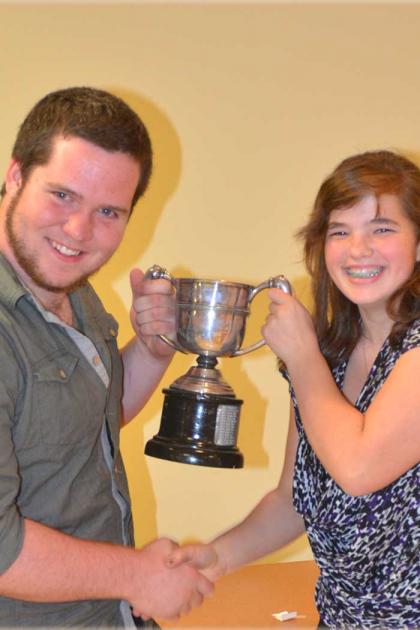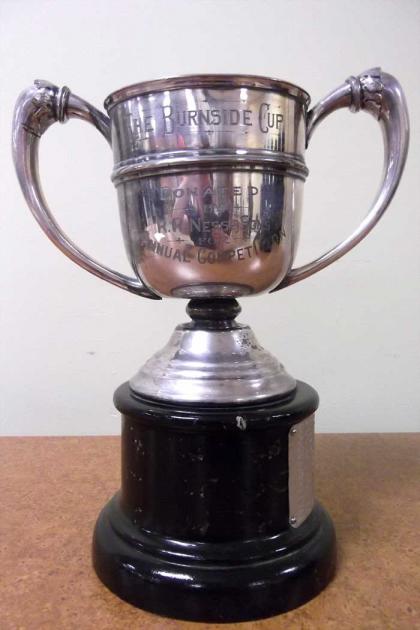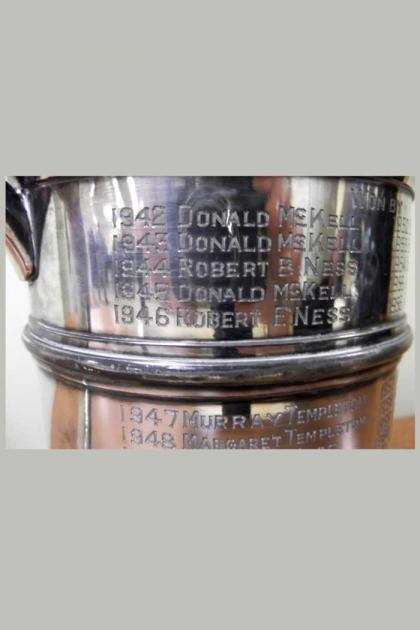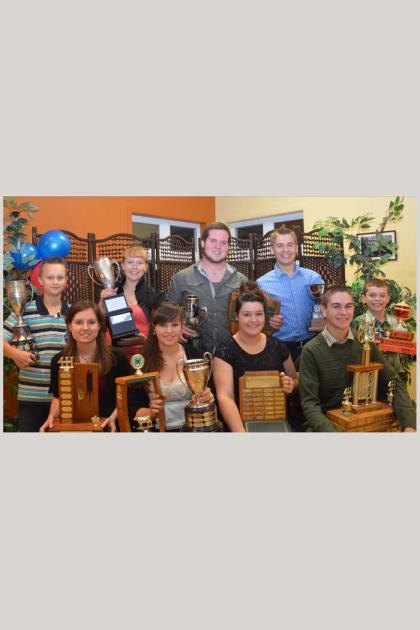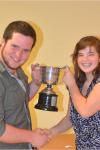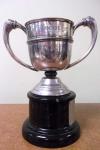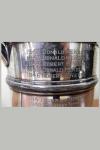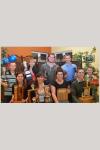The Burnside Cup
Organization: Quebec 4-H
Coordinates: www.quebec4-h.com
Address: MacDonald College, Harrison House 21-111 Lakeshore Road, Saint-Anne-de-Bellevue, QC H9X 3V9
Region: Montérégie
Contact: Angela Neal, 100quebec4h(a)gmail.com
Description: Silver award trophy presented to 4-H club members from Howick who attained the highest ranking in the senior showmanship class for dairy heifers.
Year made: circa 1942
Made by: Unknown
Materials/Medium: Silver-plate
Colours: Silver
Provenance: Unknown
Size: 26.6 cm x 25.5 cm
Photos: (1) Michel Presseau; (2-4) Lorelei Muller. Courtesy Quebec 4-H
The Burnside Cup
Angela Neal
Agriculture is one of the oldest industries in Canada, dating back to the 17th century, when the colonial settlers arrived on the shores of the St-Lawrence. In the early 20th century, a little over 300 years later, young people living in rural areas began gathering together to study about common interests they shared. They learned about good farming practices and they competed for awards and distinctions based on achievements in agriculture. These early clubs were known as “Boys and Girls Clubs” and their aim was to provide rural young people with the opportunity to learn farming and homemaking skills. Throughout the years, these clubs were identified by different names including Young Farmers’ clubs. By the 1950s, 4-H clubs were to be found in many farming communities all across the country.
Today, there is a national organization that serves the provincial 4-H associations, linking them all together, providing national as well as international opportunities for learning and personal growth to its membership. In Quebec, there are two provincial federations: Quebec 4-H, serving the Anglophone population, as well as Association des Jeunes Ruraux du Québec, our Francophone counterpart. There are 15 primarily English-speaking groups across the province. The distribution is as follows: two on the Lower North Shore, four in the Eastern Townships, five in Montérégie, one in Montreal, one in the Laurentians and two in the Outaouais region.
Quebec 4-H is a community-based organization dedicated to developing life skills such as leadership, cooperation, responsibility and independence for the English-speaking rural youth of Quebec through achievement and skill development. The motto "Learn to Do by Doing" is the basis of all 4-H activities. Members are responsible for developing and executing projects as varied as raising a calf, sewing a dress or learning photography. By helping members acquire a positive attitude toward learning, 4-H helps them increase their knowledge and develop valuable skills.
4-H clubs began at the Farmer’s Institute of Macoupin County, Missouri and the concept came to rural Quebec in 1913. These clubs still functioning under the name of Boys and Girls Clubs, existed prior to when the Quebec Young Farmers’ Provincial Federation (QYF) was formed in 1969 and they operated independently from each other and had their own activities and prospered within their communities.
Recognizing the need for a formal association, the Quebec Young Farmers’ Provincial Federation (QYF) was constituted in 1970 and at the time was comprised of 11 clubs: Brome, Hatley, Haut-Saint-François, Howick, Huntingdon, Lachute, Monterégie, Ormstown, Richmond, Sawyerville and Shawville. The Quebec Farmers’ Association and Macdonald College were instrumental to the success of the new QYF Federation.
4-H clubs are very well supported and recognised throughout their communities. Many families have donated prizes and trophies throughout the years, whether it is in honour of a value that they hold in high esteem or in memoriam of a loved one. As it is such a grassroots movement, the skills that are honed in 4-H clubs vary from region to region. However, the thread of commonality remains as rural communities have been encouraging similar values in their youth for centuries. Leadership as well as knowledge of farm practices and animals are highly commended skills in the agricultural community.
The trophy that was accepted as one of the 100 objects was donated by “R.R. Ness and Sons” for the annual Howick Achievement Day senior showmanship competition. The mastery of showmanship involves knowing how to handle an animal and present its most desirable qualities. In the Howick 4-H club, showmanship is focused around dairy heifers. A member chooses an animal in the spring of each year that he or she will be showing at fairs and competitions throughout the season (typically from June until September). The young person trains the heifer to respond to each touch of the hand, each tug of the halter and must be able to show her off to her best advantage. The senior division is the age group of 16-21. These individuals have likely grown up around the type of animal that they are showing, and have been practicing these skills for 10 years or more. The competition is very steep and it is a prestigious honour to win this trophy. Every year, at the end of the summer, the members from the Howick 4-H club participate in their achievement day and show against each other, with a judge choosing the one he sees as being the best showperson in the group. The name of the winner is then engraved on the Burnside Cup.
The first winner of the cup was Donald McKell, in 1942, and we are able to see who won this trophy every year since. Some of the names present on the cup are members of the community that have remained very involved with the 4-H movement over the years, such as Robert E. Ness, 1946. This man became a leader in the Howick 4-H club and was active for 30 years. At the Quebec 4-H Annual meeting, Mr. Ness was awarded a Queen Elizabeth II Diamond Jubilee Medal for his dedication to 4-H. Also found on the cup are names representing generations of families; father and son or mother and daughter having won the trophy during their years growing up in the 4-H fold.
The Burnside Cup is specific to one region, however many other areas also have similar trophies that they present to their members each year in the same fashion. The Burnside Cup is the oldest and represents 70 years of 4-H tradition and an incredible drive for excellence and achievement in the south-west region of the province.
Sources
Quebec 4-H, www.quebec4-h.com
4-H Clubs, www.thecanadianencyclopedia.com/articles/4h-clubs
To Learn More
4-H tradition returns to Lachute, www.agrinewsinteractive.com/archives/article-11778.htm
Chateuaguay Valley Heritage Trail, www.quebecheritageweb.com/attraction/ch-teauguay-valley
Author
Angela Neal has been a member of the Ormstown 4-H club for 14 years. She has served on the local and provincial executive and has been a member of the provincial board as well. Angela is currently working as the Quebec 4-H project Coordinator of the 100th Anniversary Project.


